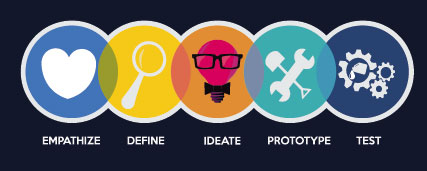These days in digital marketing, it’s not enough to have a very linear clear-cut way of thinking about users. And when you’re brainstorming, finding, and implementing new SEO marketing strategies, it can be difficult to justify spending time and resources towards a solution that may not even end up profitable.
Lately, however, more digital marketing companies have adapted the concept of design thinking into their own practices, and for good reason. With its flexible way of thinking, organised process, and ability to tackle problems and issues in your marketing strategy, design thinking in digital marketing can be a useful tool and addition to your process.
What Is Design Thinking?
Basically speaking, the process of design thinking is a non-linear solution to understanding and solving user-related problems. In older strategies, when marketers came up with ways to attract an audience, it was a very linear way of thinking that left very little room for error yet also provided very little room for growth.
Through design thinking, marketers can plan non-linear approaches to finding ways to attract the attention of users. This process challenges what marketers think they know and expands the possibilities of solutions that can be successful. Instead of focusing on traditional business models, marketers can look at what it is people really want to see and test for themselves if it is successful.
Without design thinking, marketers may not see alternative strategies or solutions that would not have been possible using traditional methodologies. This method delves into understanding not how to sell a product or service to a person, but who marketers are selling to and why they are interested in buying it.
Through design thinking, marketers use five phases – empathise, define, ideate, prototype, and test – to map out their process.
Phases of Design Thinking
The design thinking process has many variants and can differ in the number of stages, but for digital marketing, the five-stage process is the best one to describe the digital marketing process. Take note that this process is non-linear, so while it can start with empathising with your users, it doesn’t necessarily have to move through a uniform process.

Empathise
The first step is to empathise with your users or customers. Empathy is often confused with sympathy, so here’s a good example to show how sympathy and empathy works in a business and marketing sense. Let’s say that you’re the SEO services company in this case.
When you merely sympathise with a user, your company and your advertised services read like this: I understand that you need our services to help grow your business. Here are our services, we’ll provide whatever it is you ask us for if it’s within our reach. In this case, you don’t really tell your users what they need and you expect them to tell you what you want.
But to empathise with your users, you show an understanding towards what they’re feeling and what they need. When you empathise, your business sounds like this: I understand that you need our services to help grow your business. We also understand what your business is going through and we know how to help. Here are the services we can recommend you take, and let us help you understand why this package we have is ideal for your needs.
If you’ve ever tried asking people what their problems were and how you can help, you sometimes might not get a very thorough answer. So, it’s up to you to understand your customer’s situation and find out what it is they need.
Define
After empathising with your users and the problems they face, you ask: what’s their problem, what do they need, and what do you have to solve this problem? This is where you pin down what it is they want and then turn that into your main selling feature.
Ideate
At this point, you ask “What if I could solve my users’ problems by doing X, Y, and Z?” At this point, you and your team brainstorm, creating innovative solutions and answers that would not have been possible had you taken the more traditional solution.
Prototype
When you have an idea, start building on it. In the case of your SEO company, for example, let’s say that your users are small online business owners struggling to gain visibility during the new normal. You have an idea to offer SEO service packages to small business who have this issue, so you have to first build a package that’s feasible enough for your company to provide but at the same time be something that these small business owners will want.
Test
The final phase is to experiment on your solution and see if the final product would be something that customers would enjoy. Get feedback, evaluate it, recognise its strengths and weaknesses, and see if it could be a successful solution that could solve one of your users’ issues.
Design Thinking and Digital Marketing
These days, it’s important to think outside the box rather than to stick with the usual business models. After all, had the usual business models been effective in the first place, there wouldn’t be these common problems design thinking would need to solve. In terms of digital marketing, design thinking helps marketers understand their customers’ needs even before the customer realises it or asks for it.
After all, a customer will most likely not know everything there is to a product or service. The internet is filled with competitors who offer similar products and services with yours, so because of the overload of choices, it’s unlikely that a customer will come to your store and say “I want this, this, and this, and I will buy it from you.”
Instead, if you want to reach that customer, it has to be you that markets to them – and when you use design thinking, there’s a chance that your business stands out. When they happen across your website, you give the idea that basically says, “We understand what you want. Here is what you’re looking for, and here is why you should do business with us.”
So when you finally reach out to customers, you can see the process of design thinking at work.
- Empathise – As a B2B, you try to understand what your clients need to drive their own revenue. For B2Cs, you try to understand what they’re looking for and how you can help.
- Define – What do you have that your users are looking for? Are they looking for budget or luxury products? Are they looking for fast delivery? And what is it that you can provide to them?
- Ideate – Come up with a solution through various digital marketing strategies. Will better content convince them to trust your business? Do you need a bigger reach? Or has your web design made it difficult for them to navigate your website long enough for them to make a purchase or give you a call.
- Prototype – Once you’ve found a solution, it’s time to build a plan to solve your users’ problem.
- Test – Try out your prototype and see if it offers positive feedback. Take note of the areas for improvement in case there are issues in the prototype.
Digital marketing has stopped becoming a one-size-fits-all strategy, and design thinking can promote a human-centric approach to solving your users’ needs. It’s not enough to be visible and have your products lined up on your website; nowadays, it’s even more important to understand what it is your customers will want to purchase and show why they need it – and why they need it from your business.
Let us help you get the ball rolling for your business and help you stay one step ahead of your customer base. At SEO Services Australia, we’ve got the team and experience to help build your website and cater to the needs of your various types of your customers.
